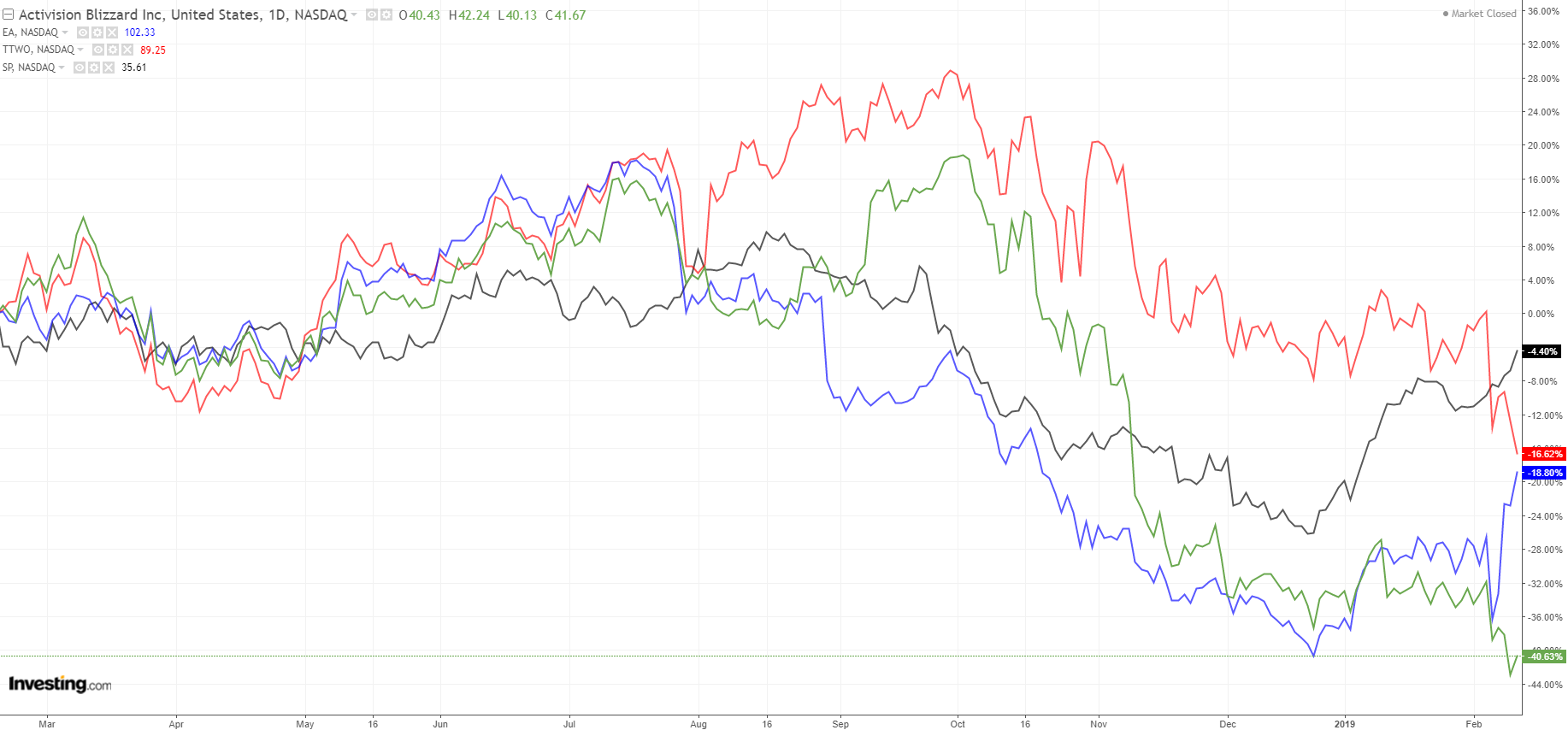The video game industry is on fire. According to a Newzoo report, the segment is expected to grow from $137.9 billion in 2018 to more than $180.1 billion in 2021. It appears to be a lucrative and potentially ever expanding market since gamers seem to be endlessly hungry for new games. At first glance, it isn’t showing any signs of slowing down.
But last week investors were given a glimpse beneath the kimono, when game studios Electronic Arts (NASDAQ:EA) and Take-Two Interactive (NASDAQ:TTWO) reported. EA missed badly, recording an EPS of just $0.86 per share on revenue of $1.3 billion, versus expectations of $1.93 EPS on $1.8 billion of revenue. Take Two fared better. It reported EPS of $3.89 on $1.2 billion in revenue, compared to consensus estimates of $2.72 and $1.5 billion, respectively.

Nonetheless, shares of both dropped dropped steeply, down 13% last Wednesday after the results were released. Of note, they dragged Activision Blizzard (NASDAQ:ATVI) shares down as well. It lost 10% on industry wide concerns.
Activision reported on Tuesday, and beat earnings expectations by one cent per share. The company also announced a $1.5 billion share buyback program, but added it would cut 800 jobs to focus more on game development. The news sent ATVI shares 3% higher in after-hours trading.
But there’s yet more to the story. Over the past 12 months, shares of Activision, EA, and Take Two lost 40%, 18% and 16% respectively, compared to the S&P 500’s 4% gain over the same period.

Something unexpected has taken the wind out of established video game studios' sales. And if that weren't enough, additional potential headwinds for the industry have cropped up.
Segment Disruptor; Microtransactions; Government Regulations
The entire segment has been disrupted by Fortnite, a free-to-play offering from privately held Epic Games, whose Battle Royale surprised the market. It also earned a hefty $3 billion dollars in profit in 2018 with 125 million registered players.
That's the most prominent current risk for this group of publicly traded companies. Government regulators, however, could also become an issue.
One of the revenue streams gaming studios have successfully used to boost profits from existing games are microtransactions, in-game sales of random content that allow users to buy additional enhancements per game for fiat currency. It's a lucrative and broadly accepted practice: of EA's $1.28 billion in revenue made during 2018, $480 million, or 37% came from extra in-game purchases. Indeed, it's become the biggest revenue segment on EA’s income statement. However, there's an element of surprise attached to the standard microtransaction since purchasers don't always know exactly what they'll be receiving.
In April of last year, regulators in the Netherlands and Belgium declared the practice a criminal violation of their respective gambling laws. EA fought the ruling but lost. Similar video game gambling regulation hasn't spread to other countries yet, but if it does, game studios will likely have a big problem.
Quality and Originality
Perhaps more challenging for the studios is the endless player appetite for ceaseless innovation. All three game studios have popular lineups but many of the titles are new iterations of older games. Customers are vocal about growing bored with some of the newer versions of older titles.
It's for this very reason we believe the Fortnite threat is only temporary. Once the Battle Royale fever ends—and it will—the publicly traded game studios, which have more experience in the market and a broader diversity of titles, will be in a better position to adapt to the next big trend. As well, all the major studios now have their own version of Battle Royale games so it's likely Fortnite's days are numbered. Indeed, on Friday, EA reported that its own newly released version of Battle Royale gained 10 million players in three days, catapulting the company’s stock higher by 16% to close the trading week.
Bottom line
From a price perspective, EA shares are nominally the most expensive, trading for $102.33, compared to 89.25 for Take Two and $41.67 for Activision. However, from a P/E perspective, EA and Take Two are relatively cheap with price-to-earnings ratios of 21 and 30 while Activision clocks in at a much higher 50. Forward P/E ratios, based on estimates for the coming year, are 24 for EA, 20 for Take Two, and 17 for Activision Blizzard. The average P/E ratio for the industry is 27, so EA and Take Two are relatively inexpensive growth plays.
Revenue TTM numbers are the highest they've ever been for all three companies. Activision leads with $7.1 billion, EA is next with $5.3 billion; Take Two came in $2.5 billion. As for Net Income TTM, EA is now leading the way with $1.4 billion, its highest figure ever, Activision is at $577 million, after a drop in earnings of 50% in the past two years, and Take Two is at $367 million, near all-time high levels.
Since Electronic Arts is the most established of the three gaming studios, with more games as well as deeper pockets, and its shares are the cheapest of the group after the recent drop, we'd recommend it for buying and hold investors looking for a good entry who'd also like to get some exposure to a growing industry. Likewise, Take Two is a promising video game studio at a reasonable valuation, and we'd recommend them as well.
Though Activision shares are the cheapest nominally, they are most highly valuated of the group, and they've also seen more serious declines this past year. While still a potentially good investment within an expanding industry, it isn’t nearly as attractive as its peers.
